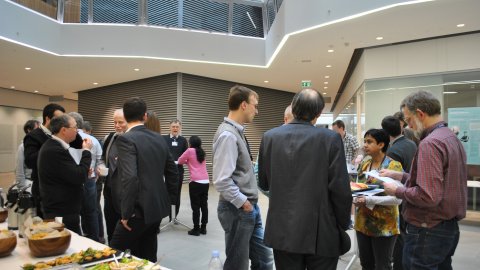11:30
Feynman integrals from the viewpoint of Picard-Lefschetz theory
Abstract
I will present work in progress with Erik Panzer, Matteo Parisi and Ömer Gürdoğan on the analytic structure of Feynman(esque) integrals: We consider integrals of meromorphic differential forms over relative cycles in a compact complex manifold, the underlying geometry encoded in a certain (parameter dependant) subspace arrangement (e.g. Feynman integrals in their parametric representation). I will explain how the analytic struture of such integrals can be studied via methods from differential topology; this is the seminal work by Pham et al (using tools and methods developed by Leray, Thom, Picard-Lefschetz etc.). Although their work covers a very general setup, the case we need for Feynman integrals has never been worked out in full detail. I will comment on the gaps that have to be filled to make the theory work, then discuss how much information about the analytic structure of integrals can be derived from a careful study of the corresponding subspace arrangement.
Correlations of almost primes
Abstract
The Hardy-Littlewood generalised twin prime conjecture states an asymptotic formula for the number of primes $p\le X$ such that $p+h$ is prime for any non-zero even integer $h$. While this conjecture remains wide open, Matom\"{a}ki, Radziwi{\l}{\l} and Tao proved that it holds on average over $h$, improving on a previous result of Mikawa. In this talk we will discuss an almost prime analogue of the Hardy-Littlewood conjecture for which we can go beyond what is known for primes. We will describe some recent work in which we prove an asymptotic formula for the number of almost primes $n=p_1p_2 \le X$ such that $n+h$ has exactly two prime factors which holds for a very short average over $h$.
What takes a mathematician to the Arctic? In short, context. The ice of the Arctic Ocean has been a rich source of mathematical problems since the late 19$^{th}$ century, when Josef Stefan, aided by data from expeditions that went in search of the Northwest Passage, developed the classical Stefan problem. This describes the evolution of a moving boundary at which a material undergoes a phase change. In recent years, interest in the Arctic has only increased, due to the rapid changes occurring there due to climate change.
When cardiac imaging meets computational modeling
Abstract
Over the past decades, the morbidity and mortality associated with cardiovascular disease have reduced due to advancements in patient care. However, cardiovascular disease remains the world’s leading cause of death, and the prevalence of myocardial pathologies remains significant. Continued advancements in diagnostics and therapeutics are needed to further drive down the social and economic burden of cardiac disease in both developed and developing countries.
Routine clinical evaluation of patients with cardiovascular disease includes non-invasive imaging, such as echocardiography (echo), cardiac magnetic resonance imaging (MRI), and/or CT, and where appropriate, invasive investigation with cardiac catheterisation However, little clinical information is available regarding the linkage between structural and function remodelling of the heart and the intrinsic biomechanical properties of heart muscle which cannot be measured in patients with cardiovascular diseases.
The lack of detailed mechanistic understanding about the change in biomechanical properties of heart muscle may play a significant role in non-specific diagnosis and patient management. Bioengineering approaches, such as computational modelling tools, provide the perfect platform to analyze a wealth of clinical data of individual patients in an objective and consistent manner to augment and enrich existing personalized clinical diagnoses and precise treatment planning by building 3D computational model of the patient's heart.
In my presentation, I will present my research efforts in 1) developing integrative 3D computational modeling platform to enable model-based analysis of medical images of the heart; 2) studying the biomechanical mechanisms underpinning various forms of heart failure using pre-clinica experimental data; 3) applying personalized modeling pipeline to clinical heart failure patient data to non-invasively estimate mechanical properties of the heart muscle on a patient-specific basis; 4) performing in silico simulation of cardiac surgical procedures to evaluate efficacy of mitral clip in treating ischemic mitral regurgitation.
My presentation aims to showcase the power of combining computational modeling and bioengineering technologies with medical imaging to enrich and enhance precision and personalized medicine.
New insights into cancer metastasis and evolution from combined experimental, clinical, and modelling analysis
Predicting atrial fbrillation treatment outcomes through mathematical modelling, signal processing and machine learning
Abstract
Catheter ablation and antiarrhythmic drug therapy approaches for treatment of atrial fibrillation are sub-optimal. This is in part because it is challenging to predict long-term response to therapy from short-term measurements, which makes it difficult to select optimal patient-specific treatment approaches. Clinical trials identify patient demographics that provide prediction of long-term response to standard treatments across populations. Patient-specific biophysical models can be used to assess novel treatment approaches but are typically applied in small cohorts to investigate the acute response to therapies. Our overall aim is to use machine learning approaches together with patient-specific biophysical simulations to predict long-term atrial fibrillation recurrence after ablation or drug therapy in large populations.
In this talk I will present our methodology for constructing personalised atrial models from patient imaging and electrical data; present results from biophysical simulations of ablation treatment; and finally explain how we are combining these methodologies with machine learning techniques for predicting long-term treatment outcomes.



